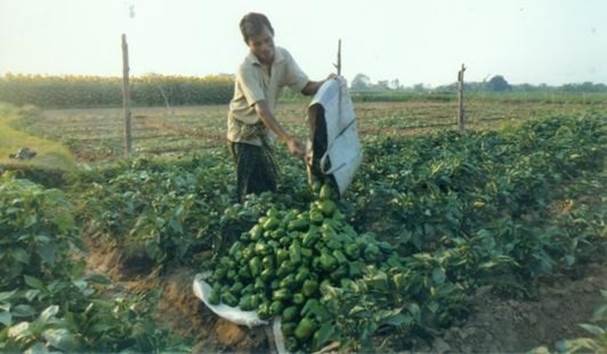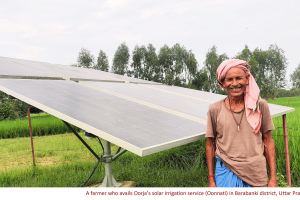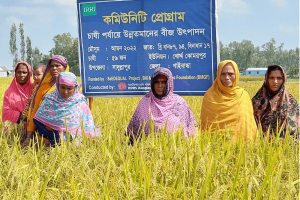As the main mandate of KVK is geared towards technology assessment, refinement and demonstration, it is not always easy to get new technologies adopted at a scale in a short period of time. However, there are certain technologies that get easily adopted at a
scale if different extension approaches are carefully deployed. P N Ananth, A K Dash and J K Sundaray illustrate one such experience here.
CONTEXT
Khordha is one of the 33 districts of Odisha (India) which has a favourable climate for cultivating cereals, pulses, oilseeds and different vegetable crops. Many varieties of vegetables are grown during the winter (Rabi) season. Krishi Vigyan Kendra (KVK)-Khordha, under the administrative control of ICAR-Central Institute of Freshwater Aquaculture, is mandated to work in Khordha district. KVK has been responsible in the district for diversifying crops, introducing new varieties, and breeding of animal and fish species with scientific package of practices for improving production and farm income.

In Odisha, capsicum (Capsicum annuum L. var. grossum Sendt) is grown on limited scale in different districts; predominantly, the supply to the state is from outside. The farmers in Khordha district used to grow chilli after paddy was harvested and were not aware of capsicum cultivation. In fact, they had the perception that it would not grow in their soil and also would not sell in the local market. KVK tried to change this preconceived idea of the farmers and introduced high-value and low-volume capsicum as part of crop diversification in the district.
Capsicum is also called bell pepper and is one of the high-valued vegetables with a high content of antioxidants. Nutritionists indicate that a small bell pepper could provide up to three times the recommended daily amount of vitamin C, compared to any citrus food. The vegetable also possesses a very high content of vitamins A, C and E (all antioxidants) that help to effectively neutralise free radicals. India contributes one-fourth of the world production of capsicum with an average annual production of 0.9 million tons from an area of 0.885 million hectare with a productivity of 1266 kg per hectare (Sreedhara et al., 2013).
GOOD PRACTICES IN PROMOTING NEW CROP ESTABLISHMENT
Awareness Building
Like any other crop introduction in the district, KVK too started organising awareness programmes for farmers to cultivate capsicum by replacing chillies to an extent with a view to increasing farmers’ income. With this initiative, KVK regularly reminded farmers that capsicum could indeed be grown in Khordha district and the market could be developed over time. A great opportunity to introduce the crop came to KVK during 2011 after floods hit the district.
Provision of seedlings
KVK worked on the flood assistance programme and farmers were provided with seedlings of vegetables. Along with other vegetable seedlings, capsicum seedlings were also provided. As the need of the hour, farmers accepted the seedlings of capsicum and were astonished to see capsicum growing and thriving in their fields. Today the crop has spread to 550 farmers in the district due to the initiation by KVK and through introduction of capsicum by state schemes.
The pathway to new crop development: It took five years to influence the farmers to adopt this crop. The timeline of the introduction is presented below:
Table 1: Timeline of capsicum as a newly introduced crop in Khordha district
| Year | 2011-12 | 2012-13 | 2013-14 | 2014-16 |
| Pathways |
in Khordha district
as flood
grown on their |
input dealers to procure and supply seeds at district level
specific testing and confirmation by KVK |
district
provides seeds to farmers in subsidised rate (post cyclone |
spread
district
|





I appreciate the approach of KVK to try something which is not in practice or farmers were not aware of (capsicum cultivation). Appreciably, this KVK could successfully demonstrate that capsicum can be grown in their soil and also it can be sold in the local market against the perception of farmers that it is not possible. KVK tried to change this preconceived idea of the farmers by introducing high-value and low-volume capsicum as part of crop diversification in the district. May be these farmers also need interactions with some successful capsicum growers in other parts, who know & have the vast experience gathered over the years on this crop. I know one capsicum grower Mr Afzal in Bareilly district who is huge reservoir of knowledge on potato & capsicum cultivation. Congratulations to the authors for bringing this practical Good Practices Note, which is quite informative.
Dear Sir, I am thankful for your quick response on our good practice note. The data which we have projected in the document is from the on farm trail. We also have the data from the Front Line Demonstrations conducted. The trend what we have understood from the farmers is that the projected yield has been achieved by most of the farmers with which we are in contact. On an average the yield is between 280-312 q/ha compared to 320 q/ha through the trail. We decided to include this crop in the district on seeing that there is a demand for capsicum especially in the markets of Bhubaneswar city. On an average if you take 1 km distance in Bhubaneswar city, you can find at least two to three small fast food shops serving noodles, chowmin and other food products for which capsicum is one of the ingredients. All the extension methods including the traditional methods were used for scaling up. KVK also worked in convergence with ATMA and other line departments. The methods we used were also influenced by the guidelines of the various schemes. But we are also using the social media where we are registering capsicum farmers on Kisan Mobile Advisory Services. We have also taken special steps to form a Farmers Producer Company to further support farmers in realising better price for their produce. Apart from these, we are introducing maize along with capsicum as an intercrop. We are sensitive to the challenges of introducing a new crop. I personally have the experience of working in Kerala when the vanilla cultivation peaked in response to the global rise in vanilla prices and how farmers suffered when the prices fell. So we have to keen these factors in view. Sir, I appreciate your quick comments and very valuable advice.
Thanks to Mruthyunjaya sir for posting his compliments. Sir we do the best and I always feel team work in extension is crucial. My many many thinks to my colleague M.r A. K. Dash who introduced this crop has taken me widely to farmers field to document and write a good practice.
Sir, I appreciate your quick comments and very valued points.I am thankful for having responded to the good practice. The data which we have projected in the document is from the on farm trail. We also have the data from the Front Line Demonstrations conducted. The trend what we have understood from the farmers is that the projected yield has been achieved by most of the farmers with which we are in contact. On an average the yield is between 280-312 q/ha compared to 320 q/ha through the trail. We derived to include this crop in the district is only by seeing that there is a demand specifically the market of Bhubaneswar city for the farmers of the district. On an average if you take 1 km distance in Bhubaneswar city you can find profusely two to three small fast food shops providing noodles, chowmin and other food products for which capsicum is one of the ingredient widely used. Traditional extension methods- all the extension methods have been used that are traditional as the works for scaling up needs in a convergence mode with ATMA and line department. The methods that we use is based on the funds provided to organise and use traditional extension methods as per guidelines. The missing link may be the recent development in using the social media however, we are working on Kisan Mobile advisory services to the registered capsicum farmers. We have also taken special steps to form a Farmers Producer Company to further support for better price for the adopters which is in process. Along with that some more additional features are that we are introducing maize along with capsicum as an intercrop. Sensitivity of introducing a new crop we have the experience of Kerala when there was a boon for Vanilla and fall down from the homesteads. Personally I have worked on Vanilla in Kerala during the crop bloom in a KVK and the consequences of new crop establishment have to be kept in mind.
Thanks. It is a very convincing success story with judicious selection/magical combination of proven technology, extension method and partnership for promotion. The team lead by Ananth cannot end with anything other than Superb Success. Maidas Touch! Congratulations! Best regards.
Thanks for circulating this article – I read it with interest since it was mentioned that different / new extension approaches were tried for introduction of Capsicum cultivation in Khordha district of Odisha. While the trial results are very encouraging I somehow miss New or Innovative element in the approch – I find that conventional approaches are tried – unless I missed it. However, credit is due for trying combination of approaches. It would be interesting to know average production of Capsicum achieved by the 550 farmers who adopted cultivation of this vegetable (recording yilds with sampled farmers) – figures from trials can sometimes be misleading. A crucial factor not mentioned / discussed in the report is steps taken to make Capsicum cultivation sustainable. KVK or any other organisation introducing new crop or variety can support up a certain period – community mobilisation is essential to sustain benefit.